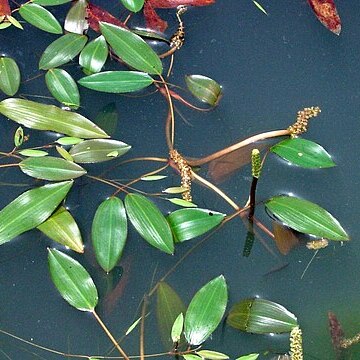Plants perennial, in fresh water. Rhizome terete, slender, with apical dormant buds. Stems terete, slender, 1.5-2 mm in diam., simple or rarely sparsely branched. Leaves dimorphic; stipules axillary, convolute, 2-7 cm, membranous, translucent, amplexicaul, often persistent, 11-19-veined; petiole 5-20 cm. Submerged leaves petiolate; blade narrowly lanceolate to lanceolate, herbaceous, often decaying early, 9-17-veined. Floating leaves petiolate; petiole 0.5-2.3 × length of blade; blade opaque, lanceolate to ovate-lanceolate or broadly elliptic, 2-10 × 1-4 cm, leathery, 11-19-veined, base obtuse or sometimes cuneate, apex acute or obtuse. Spikes cylindric, 2.5-8 cm, densely flowered, contiguous; peduncles thicker than stem, 3-10 cm. Carpels (1 or)2(or 3). Fruit broadly obovoid, 2.9-3.7 mm, abaxial keels 3, with a sharp midrib and ± obtuse lateral keels. Fl. and fr. May-Oct. 2n = 52.
A pond-weed that grows under water. It has rhizomes 20 cm deep in the soil. The leaves are mostly floating. They are narrowly oval and 10 cm long by 4 cm wide. They are on leaf stalks about 10 cm long. Flowers are on stalks 7 cm long. They are in a cylinder shaped spike 7 cm long and 1 cm thick. This bends down into the water when fruiting. The fruit have 1-4 lobes. They are 3-4 mm long.


